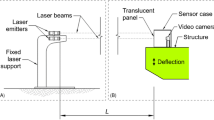Abstract
When measuring the surface subsidence of unstable areas such as railroad beds and large construction fields, it is not practical to always find stable positions to install measurement instruments. Yet installing those instruments in unstable positions will cause measurement errors or even the complete failure of long-term subsidence surveillance. In this paper, the innovative concept and its method of “displacement-relay videometrics” are proposed. With the method, a double-headed camera is designed, and two constraints, the “fixation constraint” and the “homologous constraint”, are established to construct the displacement-relay measurement equations, which can concurrently give the subsidence of the points to be measured and the positions where the cameras are fixed. The method and its measurement system are thus capable of automatically measuring the surface subsidence under the condition that the cameras are mounted on unstable locations over long durations. Therefore, the method has the broad prospect of undertaking automatic, long-term and continuous measurement for surface subsidence in engineering projects such as railroad beds, bridges and the ground beds of tall buildings. The proposed method opens a new area that cameras can be mounted on unstable platform to make high accuracy measurements, which is of great significance for applications.
Similar content being viewed by others
References
Sirivachiraporn A, Phienwej N. Ground movements in EPB shield tunneling of Bangkok subway project and impacts on adjacent buildings. Tunn Undergr Sp Tech, 2012, 30:10–24
Ozcoban S, Berilgen M, Havvanur K, et al. Staged construction and settlement of a dam founded on soft clay. J Geotech Geoenviron, 2007, 133:1003–1016
Eyers R D, Mills J P. Subsidence detection using integrated multi temporal airborne imagery. ISPRS Archives, 2004, 34:714–719
Sato H P, Abe K, Ootaki O. GPS-measured land subsidence in Ojiya City, Niigata Prefecture, Japan. Eng Geo, 2003, 67:379–390
Engelkemeir R, Khan S D, Burke K. Surface deformation in Houston, Texas using GPS. Tectonophysics, 2010, 490:47–54
Spreckels V, Wegmüller U, Strozzi T, et al. Detection and observation of underground coal mining-induced surface deformation with differential SAR interferometry, ISPRS Workshop “High Resolution Mapping from Space”. Hannover: 2001. 227–234
Tomás R, Herrera G, Delgado J, et al. A ground subsidence study based on DInSAR data: Calibration of soil parameters and subsidence prediction in Murcia City (Spain). Eng Geo, 2010, 111:19–30
Werner C, Wegmüller U, Strozzi, T, et al. Interferometric point target analysis for deformation mapping. Proc. IEEE International Geoscience and Remote Sensing Symposium (IGARSS-03), 2003, 21–25 July, Toulouse. France 7, 4362–4364
Knechtlova B, Halounova L, Hlavacova I. Subsidence monitoring in northern bohemia by method of permanent scatterers, GIS Ostrava. Ostrava, 2010. 1–7
Luhmann T, Robson S, Kyle S, et al. Close Range Photogrammetry. New York: Whittles Publishing. 2006. 15–24
Lichti D D, Habib A, Detchev I. An object-space simulation method for low-cost digital camera stability testing. Photogramm Eng Rem S, 2009, 75:1407–1414
Yu Q F, Sun X Y, Jiang G W, et al. Relay camera videometrics based conversion method for unstable platform to static reference. Sci China Tech Sci, 2011, 54:1017–1023
Läbe T, Förstner W. Geometric stability of low-cost digital consumer cameras. ISPRS Archives, 2004, 35:528–534
Habib A, Morgan M. Stability analysis and geometric calibration of off-the-shelf digital cameras. Photogramm Eng Rem S, 2005, 71:733–741
Yu Q, Jiang G, Fu S, et al. Fold-ray videometrics method for the deformation measurement of non-intervisible large structures. Appl Optics, 2009, 48:4683–4687
Jiang G, Fu S, Chao Z, et al. Pose-relay videometrics based ship deformation measurement system and sea trials. Chin Sci Bull, 2011, 56:113–118
Gao H, Cai J F, Shen Z, et al. Robust principal component analysis-based four-dimensional computed tomography. Phys Med Biol, 2011, 56:3181–3198
Candes E J, Li X, Ma Y, et al. Robust principal component analysis? J ACM, 2011, 58:1–37
Author information
Authors and Affiliations
Corresponding author
Rights and permissions
About this article
Cite this article
Yu, Q., Jiang, G., Shang, Y. et al. A displacement-relay videometric method for surface subsidence surveillance in unstable areas. Sci. China Technol. Sci. 58, 1105–1111 (2015). https://doi.org/10.1007/s11431-015-5811-6
Received:
Accepted:
Published:
Issue Date:
DOI: https://doi.org/10.1007/s11431-015-5811-6




